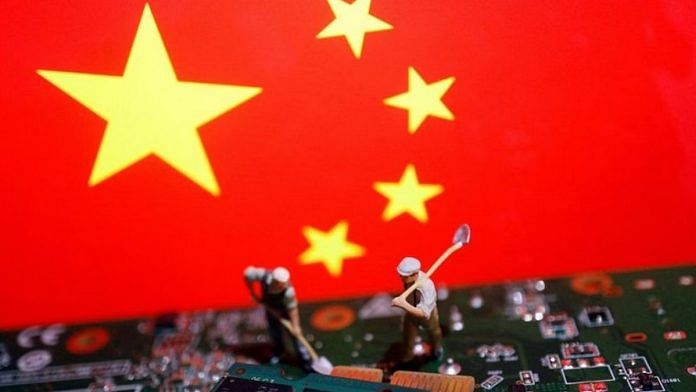


China’s $47 billion investment fund for its semiconductor sector, launched in May last year, has started bolstering the domestic chip industry. Semiconductors, often dubbed the ‘new oil,’ are crucial across sectors like electronics, automotive, telecommunications, and beyond, driving technological innovation and global competitiveness. China’s investment fund aims to localise production and reduce dependence on foreign technology, with the Semiconductor Manufacturing International Corporation—SMIC—leading the charge.
The Chinese government has rolled out policies such as the Outline for the Promotion of the Development of the National Integrated Circuit Industry, providing a framework for accelerating the growth of this pivotal sector.
From China’s vantage point, US technology restrictions are both a challenge and an opportunity. The US has long maintained global dominance through technological and economic hegemony, but as Chinese semiconductors enter global markets, China’s influence is steadily expanding. Despite US efforts to hinder its progress, China’s semiconductor industry has advanced rapidly. Many Chinese commentators see the ongoing US-China rivalry as a catalyst for growth in the semiconductor sector rather than an existential threat.
Some Chinese experts note that although US export restrictions have limited some Chinese imports from the US, their overall impact on China’s semiconductor procurement has been relatively small. China remains more reliant on Japan for semiconductors, followed by the Netherlands, and has significantly reduced its dependency on the US. As US export controls extend to allies like Japan, the Netherlands, South Korea, and Taiwan, China is diversifying its supply chains, seeking alternatives in countries such as Singapore, Malaysia, and several European nations.
A prevailing sentiment in China views US sanctions as inadvertently accelerating the country’s technological advancement. The so-called ‘showdown of the century’ between the two nations’ semiconductor industries has driven China’s innovation, fuelled by market demand and US restrictions. This has positioned China as a formidable competitor for global leadership in high-tech manufacturing. Chen Jing, a prominent tech commentator, has argued that the US government’s actions have accelerated China’s development in chip design, equipment production, and wafer fabrication, ultimately fostering its strongest rival. Hu Xijin, former editor of the Global Times, argues that the rapid expansion of China’s semiconductor sector offers the world an alternative to American chips, contributing to the diversification of global technology. While acknowledging that China’s industry still lags in some advanced technologies, Hu argues that US sanctions have harmed American companies by limiting their access to a key market.
Many in China predict the chip competition will intensify in 2025. Yu Yongding of the Chinese Academy of Social Sciences suggests that the trade war could escalate due to potential tariffs by President-elect Donald Trump. In December 2024, the US launched a Section 301 investigation into China’s mature semiconductors, defined as chips using 14nm or 28nm processes. A Weibo handle called Beijing News described this as US’ “technological bullying.”
Due to US restrictions on advanced technologies, Chinese manufacturers like SMIC have successfully ramped up their 28nm production capacity, turning mature semiconductors into a key area for domestic localisation and the embrace of “Made in China” chips. By 2024, China’s share of the global 28nm-65nm process market grew from 18 percent in 2020 to 31.5 percent. Furthermore, global companies such as STMicroelectronics and Qualcomm have shifted orders to Chinese wafer factories, further strengthening China’s semiconductor ecosystem.
Also read: India should do more than just watch US-China chip war. It’s a strategic opening
China’s semiconductor industry has experienced substantial growth in recent years, particularly in memory chips, wafer foundries, and chip equipment. The domestic semiconductor equipment market has grown 40-fold from 2008 to 2023. Companies such as North Huachuang and China Micro have demonstrated strong market performance, while players like China Resources Micro, HiSilicon, and BYD Semiconductor are making significant strides in sectors such as the Internet of Things, communications, and new energy vehicle chips. In 2023, Chinese semiconductor equipment company NAURA entered the global top 10, underscoring China’s increasing influence in the global semiconductor arena.
Chinese chip design firms are now expected to capture 15 percent of the global market share. By 2022, China already accounted for over 20 percent of global wafer fabrication capacity, with projections showing an 86 percent growth in production by 2032. Wei Shaojun, chairman of the China Semiconductor Industry Association, predicted that over 3,600 Chinese chip design companies will generate sales exceeding US$ 646 billion in 2024, with 731 companies surpassing US$ 100 million in revenue.
Prospects
China’s semiconductor industry has made significant progress but still faces challenges in high-end materials, advanced lithography equipment, and skilled labour shortages. To address these, China is focusing on government investment and international partnerships to drive growth and leadership.
While China excels in lower-end chip production, it has yet to dominate the high-end market. To bridge this gap, China is pursuing mergers and acquisitions in fields like Electronic Design Automation (EDA) and analog chips. Government policies aimed at market integration are expected to accelerate innovation.
With continued support and technological advancements, Chinese companies are narrowing the gap with global leaders. In Chinese discourse though, for China, achieving self-sufficiency and leadership in semiconductors will require sustained investment, innovation, and strategic alignment with national priorities while maintaining global engagement.
Sana Hashmi is a fellow at Taiwan-Asia Exchange Foundation. She tweets @sanahashmi1. Views are personal.
(Edited by Prashant)



